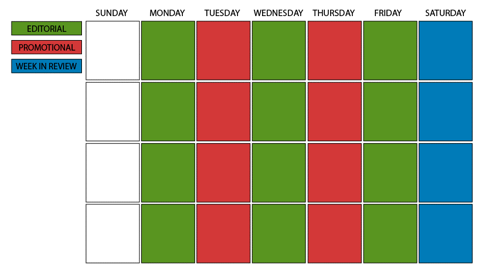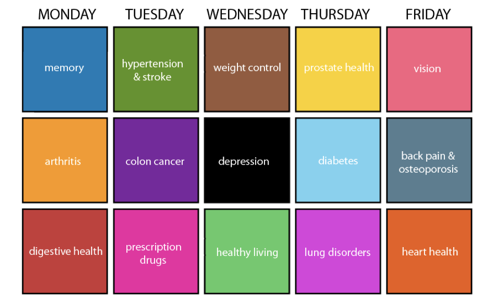Use a combination of email newsletters and email marketing promotions to build customer relationships and maximize customer lifetime value
Mequoda System Publishers use their websites to build customer loyalty and increase their email database. We’re not talking about a marketing channel you build and blast.
For Mequoda System Publishers, the email channel is a tool that provides frequent, valuable information to loyal users. This is best accomplished with a combination of email newsletters and email promotions to build customer relationships and maximize customer lifetime value.
Daily Publishing Schedule Examples
You should begin by creating an email editorial calendar that aligns with your products and sponsorships. The simplest plan works on a one-week cycle.
At Mequoda Daily, we began by sending out email newsletter tips on Mondays and Wednesdays, and email promotions or email product updates on Tuesdays and Thursdays. On Fridays, we would give away a free report or promote Mequoda Pro.

Mequoda Email Editorial Calendar
[text_ad]
Currently, we send out eight email newsletters each week – five email tips, two email promotions, plus a week-in-review summary edition on Saturdays.
Publishers with more products can have two, three and four- week cycles. Johns Hopkins Health Alerts, for example, has a three-week publishing cycle to feature all of its 15 products. The baseline sponsors are the Johns Hopkins White Papers.

Johns Hopkins Email Editorial Calendar
Email Types
A solo email newsletter, also known as an email newsletter tip, has a profit motive, and is tied to a sponsored product that is intended to generate revenue.
Typically, on Monday and Wednesday, you will use an email tips template or an article template to give added graphic identification to your newsletter.
An email product review is delivered with the same solo email newsletter template, which means it has navigation links that list other articles, etc. The difference here is that the email product review is much more focused on selling the product.
Where an editorial newsletter starts with a tip, or news story, or a report of a client experience, a product review begins with the name of the product in the headline. The product review is exclusively about the product.
Lastly, an email promotion is a classic, features-and-benefits sales letter. It carries a discreet product nameplate and is usually signed by the one of the email newsletter editors or the publisher.
The strategic intent of the email promotion is to make some kind of sale, whether it’s to purchase a product, register for an event, or some other commercial transaction. Email promotions typically trigger 60 to 70 percent of the annual spending by the average email newsletter subscriber.


